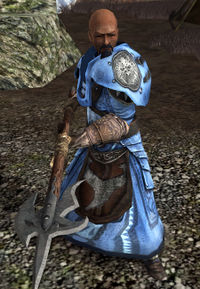The wide river Anduin separates the eastern banks of Rohan from its unkindly neighbors. We see the battles between the Easterlings and the Rohirrim most prominently in the Riders of Rohan expansion, as well as in the Great River region, where we are given a sneak-peak into the Brown Lands. Information about Easterling culture is scarce, so to flesh out these unique and distant peoples, Turbine has turned to one particularly interesting nod to the lore of Lord of the Rings.

Among the Easterling invaders, we find a group known as the Blue Caste. This cult of sorcerers wears all-blue garments and attacks with an array of spell-like skills which provide the players with a mysterious glimpse into the Easterling culture. The uninitiated may see this as a way to add magical casters into the world or fill the region with a new type of Easterling other than the typical sword-or-bow warriors, but for those who know Turbine’s track record and pay close attention to the lore of Middle-earth, other possibilites present themselves.
To fully understand how the Blue Caste connect to Arda, we must first look at some background history. Around the year 1000 of the Third Age, the Valar sent the Istari (or the Wizards) into Middle-earth. These included five powerful beings: Gandalf, Saruman, Radagast, and the two blue wizards (called Alatar and Pallando in the Unfinished Tales.) We know for certain that the two blue wizards traveled into the far eastern lands and after that, we hear absolutely nothing about them. Tolkien wrote,
“I really do not know anything clearly about the other two– since they do not concern the history of the North West. I think they went as emissaries to distant regions, East and South, far out of Númenórean range: missionaries to ‘enemy-occupied’ lands, as it were.“
Some speculate that the blue wizards were instrumental in bringing down Sauron and saving the world from his dark oppression by working their wizardry to keep the Easterlings from joining up with the dark lord; we do know, for example, that Sauron had a difficult time bringing some parts of the East under his dominion, but it is not specified why. Some believe this is the doing of these wizards.
But what if, like Saruman and Radagast, the blue wizards failed in their task of uniting the Free Peoples somehow or were derailed or distracted? Tolkien elaborates on one such possibility in a letter he wrote:
“What success they had I do not know; but I fear that they failed, as Saruman did, though doubtless in different ways; and I suspect they were founders or beginners of secret cults and ‘magic’ traditions that outlasted the fall of Sauron.“
Is it possible that the Blue Caste sorcerers are a part of a magical cult founded by one of the blue wizards? While Turbine does not have the rights to use these letters as source material for their game, I think it is fairly safe to say that the Blue Caste is a subtle nod to the work of Tolkien, and just one more of many ways that Turbine has woven the intricate details of Middle-earth into its tapestry.

(Information gathered mainly from Letter 211 of The Letters of J.R.R. Tolkien.)

Always something new to learn while playing LOTRO! Most interesting, thank you!
Loved reading this! Thanks!
Its nice to see someone brings these ideas together 🙂 However, I think that the Blue Caste of the Brown-Lands (and the Wold) are associated with one of the two Istari, who, it seems, has fallen into evil ways.
The Easterling names given to the two blue wizards in LOTRO (although not explicitly referred to as such) are, if I remember correctly, are Yirokshar and Yeltkin (not entirely sure on the second one).
If you run the instance the Bells of Dale, in the final boss encounter, the Easterlings there make it clear that their master is Yeltkin the Violet, a different one to the Yirokshar referred to by the Easterlings of the South, however, the dialogue of the boss makes it clear that Yeltkin was indeed working against Sauron, and told his people not to head westwards, although they disobeyed him.
While the above isn’t as well researched as what you’ve got in the article above, I hope it provides a starting point for others to go and look into the blue wizards during their own time in the game 🙂
I appreciate your insight! I have not run the Bells of Dale, but I think I’ll have to now to glean what I can from the dialogue you’ve pointed out. 🙂